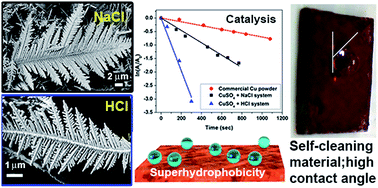Solution chemistry-based nano-structuring of copper dendrites for efficient use in catalysis and superhydrophobic surfaces†
Abstract
Despite their performance and economic advantages over Ag and Au, there have been no focused research efforts on the nano-structuring of Cu dendrites with respect to fine-tuning their structure/morphology towards the efficiency enhancement of suitable applications. Reported here is a simple, versatile, environmentally-friendly and galvanic replacement reaction-based solution chemistry methodology to synthesize highly nano-structured copper dendrites targeted towards the efficiency enhancement of desired applications. Herein, copper is deposited galvanically on an Al foil in the presence of NaCl/HCl, wherein the chloride anions augment an uninterrupted replacement reaction. The growth process of Cu dendrites has been probed in detail. The presence of acid, the type of Cu2+ precursor salt, the Cu2+ ion concentration, the surfactant concentration and the reaction temperature are all demonstrated to provide useful means of modulating the surface structure/morphology of the dendrites. Notably, dendrites formed in the presence of acid are found to be highly nano-structured. Moreover, it is also found that the morphology/structure of the obtained Cu deposit depends considerably upon the choice of the Cu2+ precursor salt, a parameter that has been completely overlooked in the past. The acid-induced nano-structuring of the dendrites is exploited for enhancing their efficiency in the catalytic reduction of para-nitrophenol and for fabricating self-cleaning superhydrophobic surfaces. These nano-structured dendrites are demonstrated to have the highest ever normalized rate constant for the catalytic reduction reaction. Superhydrophobic surfaces fabricated using these dendrites demonstrate excellent self-cleaning abilities, showing a high contact angle (159°) with low contact angle hysteresis (2°). This facile synthetic strategy for the fabrication of highly nano-structured Cu dendrites is expected to open up avenues for the production of Cu-based low-cost functional nano/micro-materials.

- This article is part of the themed collections: Editors Collection for RSC Advances - India and Surface enhanced Raman Spectroscopy: Editors collection for RSC Advances

 Please wait while we load your content...
Please wait while we load your content...